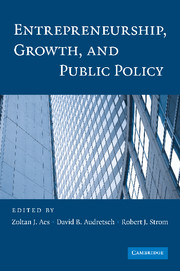Book contents
- Frontmatter
- Contents
- Contributors
- Acknowledgments
- ENTREPRENEURSHIP, GROWTH, AND PUBLIC POLICY
- 1 Introduction: Why Entrepreneurship Matters
- PART I THE ROLE OF ENTREPRENEURSHIP IN INNOVATION
- PART II LINKING ENTREPRENEURSHIP TO GROWTH
- PART III POLICY
- 10 Entreprenomics
- 11 The Bayh-Dole Act and High-Technology Entrepreneurship in the United States during the 1980s and 1990s
- 12 Academic Entrepreneurship in Europe
- 13 Creating an Entrepreneurial Economy
- 14 “Entrepreneurial Capitalism” in Capitalist Development
- Index
- References
11 - The Bayh-Dole Act and High-Technology Entrepreneurship in the United States during the 1980s and 1990s
Published online by Cambridge University Press: 05 June 2012
- Frontmatter
- Contents
- Contributors
- Acknowledgments
- ENTREPRENEURSHIP, GROWTH, AND PUBLIC POLICY
- 1 Introduction: Why Entrepreneurship Matters
- PART I THE ROLE OF ENTREPRENEURSHIP IN INNOVATION
- PART II LINKING ENTREPRENEURSHIP TO GROWTH
- PART III POLICY
- 10 Entreprenomics
- 11 The Bayh-Dole Act and High-Technology Entrepreneurship in the United States during the 1980s and 1990s
- 12 Academic Entrepreneurship in Europe
- 13 Creating an Entrepreneurial Economy
- 14 “Entrepreneurial Capitalism” in Capitalist Development
- Index
- References
Summary
Introduction
Assessments of the economic contributions of high-technology entrepreneurs and entrepreneurship to U.S. economic growth and competitiveness have shifted somewhat since the 1980s. During the 1990s, the era of the “New Economy,” numerous observers hailed the resurgent economy in the United States as an illustration of the power of high-technology entrepreneurship. The new firms that a decade earlier had been criticized by such authorities as the MIT Commission on Industrial Productivity for their failure to compete successfully against non-U.S. firms were seen as important sources of economic dynamism and employment growth. Indeed, the transformation in U.S. economic performance between the 1980s and 1990s is only slightly less remarkable than the failure of experts in academia, government, and industry to predict it.
University–industry research collaboration and technology transfer, especially the licensing by U.S. universities of patented inventions, was cited by a number of accounts as a central cause of U.S. economic resurgence in the 1990s, and the Bayh-Dole Act of 1980 has been credited for growth in such collaboration. Implicit in many of these characterizations was the argument that university patenting and licensing have enhanced high-technology entrepreneurship and the economic contributions of U.S. university research. Similar characterizations of the effects of the Bayh-Dole Act have been articulated by the President of the Association of American Universities and the Commissioner of the U.S. Patent and Trademark Office.
- Type
- Chapter
- Information
- Entrepreneurship, Growth, and Public Policy , pp. 250 - 283Publisher: Cambridge University PressPrint publication year: 2009
References
- 1
- Cited by



